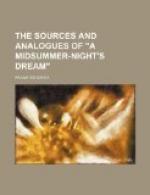Book VII, chap. ii.
“Know you this by the way, that heretofore Robin Goodfellow and Hobgoblin were as terrible, and also as credible to the people, as hags and witches be now: and in time to come a witch will be as much derided and contemned, and as plainly perceived, as the illusion and knavery of Robin Goodfellow. And in truth, they that maintain walking spirits with their transformation, &c, have no reason to deny Robin Goodfellow, upon whom there hath gone as many and as credible tales as upon witches; saving that it hath not pleased the translators of the Bible to call spirits by the name of Robin Goodfellow, as they have termed diviners, soothsayers, poisoners, and cozeners by the name of witches.”
Book VII, chap. xv.
“But certainly some one knave in a white sheet hath cozened and abused many thousands that way; specially when Robin Goodfellow kept such a coil in the country.... They [our mothers’ maids] have so fraid us with bull-beggars, spirits, witches, urchins, elves, hags, fairies, satyrs, pans, fauns, sylens, Kit with the canstick[2], tritons, centaurs, dwarfs, giants, imps, calkers, conjurors, nymphs, changelings, Incubus, Robin Goodfellow, the spoorn, the mare, the man in the oak, the hell-wain, the fire-drake, the puckle, Tom Thumb, hobgoblin, Tom tumbler, boneless, and other such beings, that we are afraid of our own shadows.”
Book XIII, chap. xix. [To set an horse’s or an ass’s head on a man’s neck and shoulders.] (See p. 30.)
The words used in such case are uncertain, and to be recited at the pleasure of the witch or cozener. But at the conclusion of this, cut off the head of a horse or an ass (before they be dead, otherwise the virtue or strength thereof will be the less effectual), and make an earthen vessel of fit capacity to contain the same, and let it be filled with the oil and fat thereof, cover it close, and daub it over with loam; let it boil over a soft fire three days continually, that the flesh boiled may run into oil, so as the bare bones may be seen; beat the hair into powder, and mingle the same with the oil; and anoint the heads of the standers by, and they shall seem to have horses’ or asses’ heads.
Discourse upon Devils and Spirits, chap. xi.




